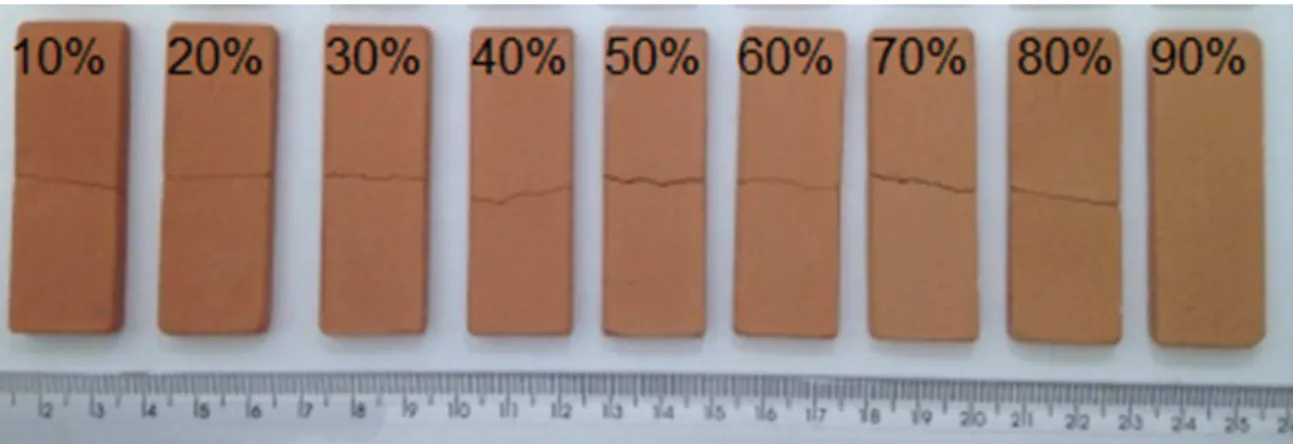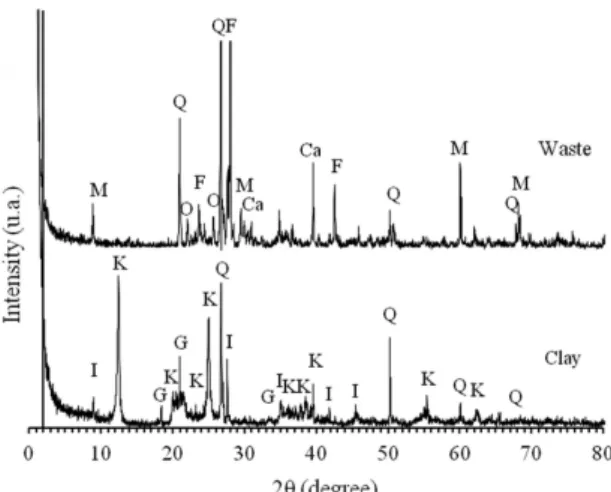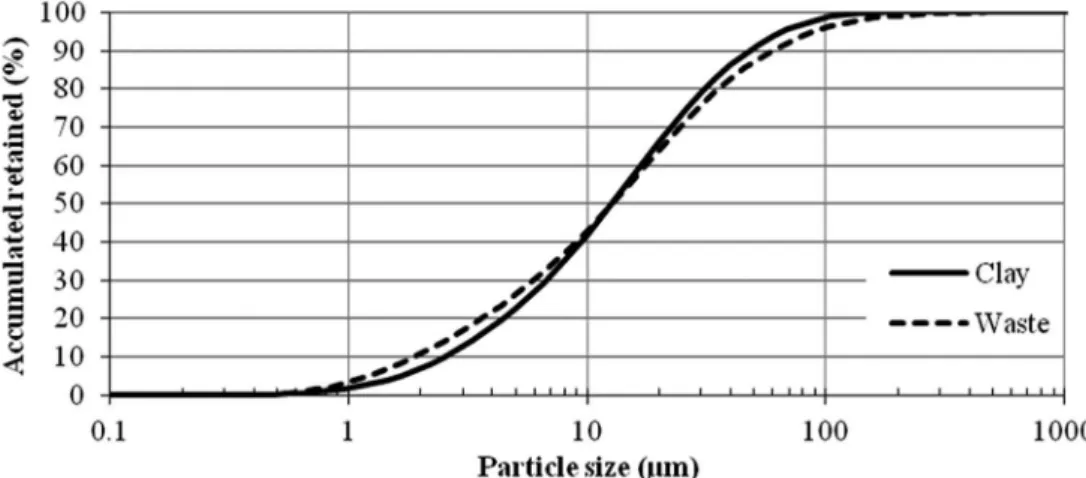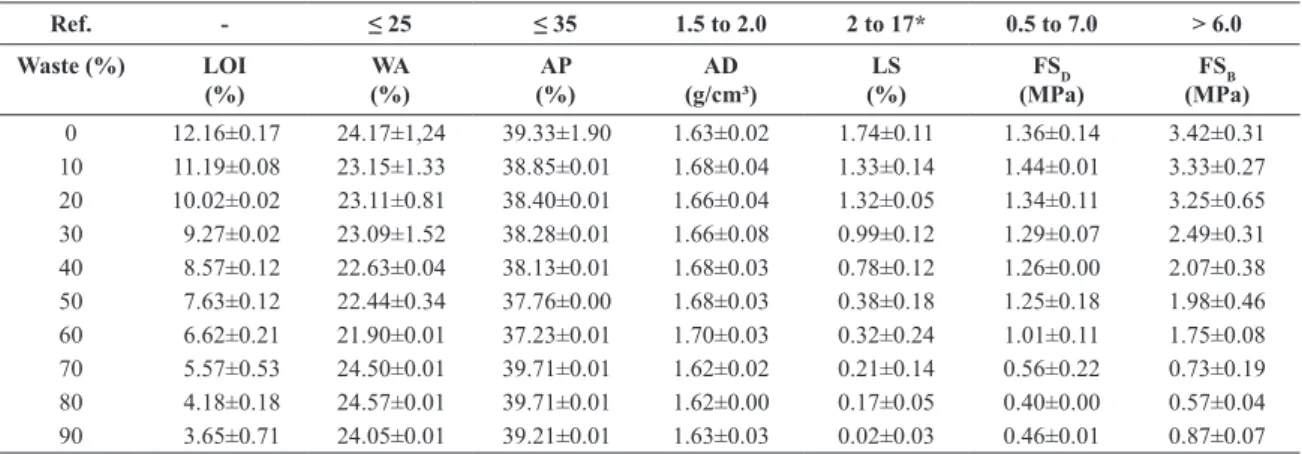*e-mail: alessandrar@ifes.edu.br
1. Introduction
The dimension stones factory has greatly developed over the years and presents a great increase in production. According to the Associação Brasileira da Indústria de Rochas Ornamentais – ABIROCHAS1, around 2.7 million tons of dimension stones were exported in 2013, and the participation of the processed stones in the physical export volume was 47.0%.
The state of Espírito Santo, in the southeast region of Brazil, stands out as the main producer and the greatest processor and exporter of dimension stones in Brazil, accounting for 64.5% of the Brazilian stones production1 with the other states in the region.
Dimension stone processing generates waste that can cause undesirable environmental impacts, especially if improperly disposed. Sawing dimension stone blocks into plates in the looms of metallic blades generates waste in the form of mud containing stone powder, steel grit, lime and water. After drying, the mud produces a large volume of very ine powder due the great industrial production, which represents
about 30% of the block volume2. In 2013, 3.7 million tons of waste were generated from stone processing1 in Brazil.
Waste reuse is a way to make the dimension stone industry more environmentally sustainable, minimizing disposal in landills, or avoiding improper disposal, which can cause soil, air and water contamination.
Furthermore, clayey materials used in the structural ceramic industry show an extensive range of compositions, allowing the incorporation of a variety of industrial waste materials, such as dimension stone waste.
The literature presents studies on the use of dimension stone waste in structural ceramic clayey masses3-10 with contents varying from 10% to 60% (wt.). The technical feasibility of using waste in the researches was based on results from water absorption, apparent porosity and mechanical strength in specimens ired at temperatures ranging from 800°C to 1150°C in laboratory furnaces in which the temperature varies linearly. The improvements in characteristics occurred in contents varying from 10% to 40% of waste3-10. Besides the research into the use of dimension stone waste in structural ceramic products, several applications can be cited, such
Analysis of Dimension Stone Waste Addition to the Clayey Mass
Used in Roof Tile Production
Alessandra Savazzini dos Reisa*, Viviana Possamai Della-Sagrillob,
Francisco Rolando Valenzuela-Diazc
aInstituto Federal do Espírito Santo, Avenida Arino Gomes Leal, 1700, Santa Margarida,
CEP 29700-660, Colatina, ES, Brazil
bInstituto Federal do Espírito Santo, Avenida Vitória, 1729, Jucutuquara,
CEP 29040-780, Vitória, ES, Brazil
cDepartament of Metalurgical and Materials Engineering, Universidade de São Paulo – USP,
Avenida Professor Mello Moraes, 2463, Butantã, CEP 05508-030, São Paulo, SP, Brazil
Received: November 7, 2014; Revised: November 18, 2015
Addition of dimension stone waste to clayey mass is an alternative to make the dimension stone sector more environmentally sustainable and to reduce the consumption of clayey raw material. Our aim is to study the technical feasibility of dimension stone waste addition to the clayey mass used in roof tile production. Samples of waste and clay were tested for physical, chemical, mineralogical and microstructural characterization. Samples containing dimension stone waste contents, varying from 10% to 90% (wt.), were produced and burned in industrial furnace of a structural ceramic factory at a 900°C maximum temperature for 24 hours. The technological characteristics evaluated were water absorption, apparent porosity, apparent density, loss on ignition, linear shrinkage and lexural strength. The results show that the samples with up to 60% waste content can be used in the production of ceramic bodies, since the waste promoted the physical packing of the grains, which increased the densiication of ceramic bodies. With that, the waste-improved ceramic characteristics were analyzed. From 60% content onwards, the waste was not be able to ill the remaining interstices between the clay grains to densify the ceramic body because both raw materials have similar particle size distribution. Furthermore, the excess silica, in the form of quartz contained in the waste, presents an inert behavior in the factory iring temperature used in this research, causing fracture points and decreasing the lexural strength.
as cement mortar, porcelain, lime-silica brick, soil-cement brick, concrete, asphalt, cement industry, plastic and rubber industry, tactile loor hydraulic tile11 and agriculture. The author emphasizes that most researches with dimension stone waste failed to become technological innovations11. This problem needs to be solved by approaching academic research to the productive sector.
We therefore aim to study the technical feasibility of dimension stone waste addition to the clayey mass used in roof tile production. The research was conducted at the factory to reduce the research time from laboratory to large-scale production test. With that, the research took into consideration the iring temperature and the same conditions used in the industry for manufacturing roof tiles. Based on the results, roof tiles will be thereafter produced at the factory with the tested mixture.
2. Material and Methods
The clay is extracted from a quarry located in Itapina-ES-Brazil. The waste is generated in a cutting and polishing dimension stones industry located in Colatina-ES-Brazil.
The clay and waste do not undergo any type of treatment before entering the structural ceramic production. The iron particles from saws were not removed from the dimension stones waste. Samples of clay and dimension stone waste were collected directly from storage piles of the structural ceramic factory located in Colatina-ES, using waste sampling procedures speciied by the Brazilian Standard NBR 10007/2004[12] (Sampling of Solid Waste) After that, the samples were air-dried, broken with the aid of a pounder, homogenized and quartered. Part of the material was used for characterization tests, and part for preparing the specimens. The materials were characterized by X-ray luorescence (XRF) in a Philips PW2400 spectrometer; X-ray diffraction
(XRD) with copper source (K α radiation) in Philips X- Pert MPD equipment; scanning electron microscopy (SEM) in a Philips XL-30 electron microscope; particle size analysis by laser diffraction in Malvern Mastersizer 2000 equipment. And the plasticity was evaluated using Atterberg’s consistency limits13,14.
The materials were sieved in ABNT (Brazilian Association of Technical Standards) # 80; mixtures of clay with dimension stone waste in contents varying from 10% to 90% (weight) and solely of clay (0% waste) were prepared.
Prismatic specimens (bars) were made (Figure 1), measuring 20 mm × 60 mm × 5 mm by axial pressing at 250 kgfcm–² according to Souza Santos’s methodology15,16. The bars were
oven dried for 24 hours at 110°C and the lexural strength was measured. Part of the bars was burned for 24 hours in an industrial tunnel-type furnace in a structural ceramic factory at a maximum 900°C temperature in the burning zone for about 6 hours. The burning of the bars was performed in the ceramic factory to simulate the real variation in temperature of a furnace, which will be used for producing the roof tiles with the test mixture.
After iring, the following characteristics were evaluated: water absorption, apparent porosity, apparent density, lexural strength, linear shrinkage and loss on ignition in bars according to Santos15,16.
3. Results and Discussion
3.1. Chemical and mineralogical
characterization of raw materials
The chemical analysis in Table 1 shows that the clay presents typical chemical composition of clayey raw material, with a predominance of silica and alumina, with values of 43.39% and 30.16%, respectively. These contents are within
Figure 1. Examples of burned bars of clayey mass with dimension stone waste (after rupture) with contents from 10% to 90% (wt) after rupture.
Table 1. Chemical composition of clay and dimension stone waste by XRF.
Composition expressed in oxides (% wt)
SiO2 Al2O3 Fe2O3 TiO2 K2O MgO P2O5 Na2O CaO BaO LOI
Clay 43.39 30.16 9.29 1.39 1.25 0.62 0.12 0.17 0.24 - 13.17
Waste 62.88 14.11 5.72 0.67 4.36 1.02 0.38 2.54 4.42 0.22 2.97
the ranges from 43.20% to 77.60% for silica and from 6.80% to 38.00% for alumina15,16 and indicate the presence of kaolinite10,15. The 9.29% iron oxide is responsible for
the reddish color after iring. The non-signiicant value of K2O (1.25%) found in the XRF indicates the presence of illite; a fact also reported by Taguchi et al.10. Furthermore, the concentration of (Na2O + K2O = 1.42%) is not high; therefore, even being luxing oxides, they contribute little to the formation of the glassy phase during iring. The clay in question is silica-aluminous, with high iron content and low luxing oxides content, requiring high sintering temperatures17. The value of 13.17% loss on ignition is in the range of 6.00% to 15.70%, required by Santos15,16, speciic for clayey raw material of structural ceramic, indicating that there was burning of organic matter and possible decomposition of carbonate. Characteristics, such as high amount of kaolinite clay mineral, high loss on ignition, presence of hydroxides, small amount alkaline luxes can lead to a refractory clay behavior which can impair sintering during the iring process18.
The chemical analysis of the waste showed it is a silica-aluminous material. The high amount of SiO2 (62.88%) is associated to the crystalline phase of quartz. The waste added to the clay can help change the plasticity and improve the clay drying step due to its high content of free silica19. However, excess quartz may hinder extrusion and reduce the dry mechanical strength; at the iring step, it may behave as an inert phase and generate microcracks, due to the allotropic transformation of quartz around 573°C[19]. Therefore, the amount of silica present in the waste is to be taken into consideration to prevent the problems mentioned. The presence of alkaline oxides in the waste (Na2O + K2O = 6.93%) can contribute to burning ceramic bodies because they are luxing oxides. The presence of Fe2O3 is associated to steel
grit; and CaO, which can act as luxing19, associated to lime, both used in the mud. The waste has low loss on ignition in relation to the clay, which means dimensional stability of waste for heat treatment. The low value of loss on ignition and the high contents of silica and alumina suggest that the stone is granitic4.
The X-ray diffraction of the raw materials is shown in Figure 2. The XRD of clay indicates that the predominant clay mineral is kaolinite, which corroborates the result of XRF, because clay with a high content of Al2O3 and a low percentage of luxing oxides generally presents kaolinite as its main clay mineral10. Peak characteristics were also detected: illite, goethite (probably due to the high Fe2O3 content); and quartz.
In the case of waste, XRD indicates the presence of quartz, feldspar, mica and calcite: main mineral constituents of dimension stones19. The primary minerals, mica and feldspar found in the waste have K2O e Na2O in the composition, the oxides accounting for the formation of the liquid phase.
The crystalline phases identiied in the raw materials are in agreement with the results from the XRF (Table 1).
3.2. Physical and microstructural
characterization of raw materials
Atterberg limits on the raw materials are presented in Table 2. The clay plasticity index (PI) is 21.2%, above 15.0%, indicating high plasticity, which makes it suitable for molding by extrusion. However, this amount of clay PI
can lead to a larger amount of water necessary for extruding pieces, thus requiring longer drying. Regarding the plasticity limit (PL), the 38.4% value is within the range from 9.0% to 56.0% speciied by Santos15,16 for kaolinitic clay, conirming
the predominance of the kaolinite mineral identiied in XRD. Attempts were made to determine the plasticity limit of dimension stone waste, but the experiments were not successful, as in the work by Moreira et al.4. Therefore, the waste is not a plastic material, which can contribute to achieving ideal plasticity of the mixture in the extruder.
The particle size distribution of the clay and the waste are shown in Figure 3. The effective diameter of the clay is 2.9 µm and the waste is 2.2 µm. These are very close values, indicating that both raw materials have similar particle size distribution. The clay and the dimension stone waste have about 40% grains larger than 20 µm; 50% grains between 2 µm and 20 µm, and less than 10% grains smaller than 2 µm. The clay has low “clay fraction” (grains smaller than 2 µm), presenting plasticity due to the organic matter contained in the clay.
Figure 4 presents images showing the material morphology and particle size obtained by electron microscopy. The images show that the grains are irregular in shape tending to form slender and lamellar particles, some scattered and others in clumps forming larger particles. The formation of these clumps between very thin particles may increase the porosity of the ceramic bodies20. The grain size ranged from 2 µm to 46 µm in the clay; and from 2 µm to 42 µm in dimension stone waste.
3.3. Ceramic characterization
The ceramic characteristics obtained from the specimens of clayey mass with dimension stone waste in contents 0%, 10%, 20%, 30%, 40%, 50%, 60%, 70%, 80% and 90% (wt)
Table 2. Atterberg limits of clay and dimension stone waste. Plasticity Limit-PL (%) Liquid Limit-LL (%) Plasticity Índex-PI (%)
Clay 38.4 59.6 21.2
Waste n.d. 28.1 n.d.
n.d.: not determined.
Figure 3. Particle size distribution curve of of clay and dimension stone waste.
Figure 4. SEM of (a) clay – 1000x; (b) clay – 15000x; (c) dimension stone waste – 1000x; (d) dimension stone waste – 15000x.
are shown in Figures 5-8 and are summarized in Table 3, which presents the average and standard deviation of the values obtained.
Figure 5 shows the behavior of the loss on ignition (LOI) and the linear shrinkage (LS) of the clayey specimens with the addition of waste. The loss on ignition and linear shrinkage values decreased with the increasing content of waste. Thus,
the waste promoted greater dimensional stability to ceramic bodies, because it contains high silica content, which may result in crack reduction due to shrinkage, corroborating the work by Rodrigues et al.9 and Taguchi et al.10.
present the same behavior observed for apparent porosity once those characteristics were dependent. The water absorption and apparent porosity values decreased with the increase in waste content, showing the main effect of the waste on the densiication of the ceramic body. This happened up to 60% waste, in which minimum percentage of water absorption and apparent porosity was obtained.
As from 60%, the waste was not be able to ill the remaining interstices between the clay grains to densify the ceramic body seeing that both raw materials have similar particle size distribution. Thus, there was no physical packing of the grains or the expected densiication. Water absorption met the maximum limit of 25% speciied for Brazilian standard clays15,16, while apparent porosity did not meet the maximum limit of 35%[15,16].
Figure 7 allows observing that the apparent density (AD) presented maximum value of 1.70 gcm–3 for 60% waste,
conirming the samples maximum densiication. This had been observed before with the minimum values found for absorption and porosity at 60% waste.
Table 3 shows that the apparent density values ranged from 1.62 gcm–3 to 1.70 gcm–3, according to the 1.50 gcm–3 to 2.00 gcm-3 range prescribed by Santos15,16 for clayey mass used in structural ceramic.
Figure 8 presents the lexural strength behavior of the specimens, both dried and burned. With the addition of the dimension stone waste in ceramic bodies, the lexural strength of dried and burned specimens decreased. This occurred since the excess silica in the form of quartz contained in the waste presents an inert behavior at the industrial iring temperature used in this research. Thus, quartz causes fracture points decreasing the lexural strength in the specimens with high waste content. Low lexural strength in ceramic bodies is also attributed to the presence of quartz from the dimension stone waste according to some authors8,19,21,22.
Table 3 shows that the lexural strength in the specimens dried up to 70% waste content meet the Brazilian standard clays15,16 to be used in structural ceramics, from 0.50 MPa to
7.00 MPa. However, the lexural strength of burned specimens did not meet the minimum value of 6.00 MPa[15,16]. Despite
the unsatisfactory results of lexural strength after burning, comparing the values obtained from specimens made solely of clay with mixtures containing waste, there appears to have been improvements, conirming the beneicial action of waste in the ceramic bodies.
Another factor that may have inluenced the low values of lexural strength of the burned specimens is the low iring temperature (maximum 900°C), which is not suficient to complete the glassy phase formation, not inluencing the decrease in porosity. The inluence of temperatures below 900°C in porosity was also observed by Pinheiro & Holanda22, which recommend that this iring temperature is more favorable for manufacturing blocks instead of roof tile. With the maximum burning temperature of 900°C tested for this work, sintering occurred by solid diffusion18, due to the greater number of contacts between the clay and waste ine particles and to the physical packing between the grains, which is conirmed by other studies8,18,23,24.
Figure 5. Loss on ignition (%) and linear shrinkage (%) as a function of dimension stone waste content (%).
Figure 6. Water absorption (%) and apparent porosity (%) as a function of dimension stone waste content (%).
Figure 7. Apparent density (gcm–3) as a function of dimension stone waste content (%).
4. Conclusions
The chemical and mineralogical characterization of clay, proved to be predominantly kaolinitic, containing suitable quartz and iron contents and it may have refractory behavior. The clay and the dimension stone waste may be considered silica-aluminous materials; the waste still contains luxing oxides that can assist in the ceramic bodies iring process. The clay has high plasticity, while the waste is not a plastic material. Both raw materials have similar particle size distribution, and grains are irregular in shape, some scattered and others in clumps. The results show that the samples with up to 60% waste content are proper for being used in the production of ceramic bodies, since the waste promoted the physical packing of the grains, which increased the densiication of ceramic bodies. With that, the waste improved the ceramic characteristics analyzed. From the 60% content onwards, the waste was not be able to ill the
Table 3. Ceramics characteristics of clayey mass with dimension stone waste in contents ranging from 10% to 90% and solely of clay (0%) - averages and standard deviations.
Ref. - ≤ 25 ≤ 35 1.5 to 2.0 2 to 17* 0.5 to 7.0 ˃ 6.0
Waste (%) LOI (%) WA (%) AP (%) AD (g/cm³) LS (%) FSD (MPa) FSB (MPa)
0 12.16±0.17 24.17±1,24 39.33±1.90 1.63±0.02 1.74±0.11 1.36±0.14 3.42±0.31
10 11.19±0.08 23.15±1.33 38.85±0.01 1.68±0.04 1.33±0.14 1.44±0.01 3.33±0.27
20 10.02±0.02 23.11±0.81 38.40±0.01 1.66±0.04 1.32±0.05 1.34±0.11 3.25±0.65
30 9.27±0.02 23.09±1.52 38.28±0.01 1.66±0.08 0.99±0.12 1.29±0.07 2.49±0.31
40 8.57±0.12 22.63±0.04 38.13±0.01 1.68±0.03 0.78±0.12 1.26±0.00 2.07±0.38
50 7.63±0.12 22.44±0.34 37.76±0.00 1.68±0.03 0.38±0.18 1.25±0.18 1.98±0.46
60 6.62±0.21 21.90±0.01 37.23±0.01 1.70±0.03 0.32±0.24 1.01±0.11 1.75±0.08
70 5.57±0.53 24.50±0.01 39.71±0.01 1.62±0.02 0.21±0.14 0.56±0.22 0.73±0.19
80 4.18±0.18 24.57±0.01 39.71±0.01 1.62±0.00 0.17±0.05 0.40±0.00 0.57±0.04
90 3.65±0.71 24.05±0.01 39.21±0.01 1.63±0.03 0.02±0.03 0.46±0.01 0.87±0.07
Ref.: reference values15,16; LOI: loss on ignition; WA: water absorption; AP: apparent porosity; AD: apparent density; LS: linear shrinkage; FSD: lexural strength dry; FSB: lexural strength burning. *values for kaolinite clays15,16.
remaining interstices between the clay grains to densify the ceramic body due both raw materials having similar particle size distribution. Additionally, the excess silica, in the form of quartz contained in the waste, presents an inert behavior at the factory iring temperature used in this research, which causes fracture points and decreases the lexural strength.
It also conirms the need to increase the iring temperature to reduce porosity, to form the liquid phase to dissolve the quartz, resulting in increased lexural strength of ceramic bodies.
The approach used herein, performed with the actual manufacturing conditions, can be said to greatly facilitate the passage from laboratory studies to industrial scale.
Acknowledgements
The authors thank IFES and USP/PMT.
References
1. Associação Brasileira da Indústria de Rochas Ornamentais – ABIROCHAS. Balanço das exportações e importações brasileiras de rochas ornamentais em 2013. Inf. 01/2014. São
Paulo: ABIROCHAS; 2014. Available from: ˂http://www. ivolution.com.br/mais/fotos/6/17/3050/Informe_01_2014.pdf˃.
Access in: 15 Aug 2014.
2. Reis AS and Alvarez CE. A sustentabilidade e o resíduo gerado no beneficiamento das rochas ornamentais. In: Anais II Encontro Latino Americano de Ediicações e Construções Sustentáveis – II ELECS; 2007; Campo Grande, Brasil. Porto Alegre: ANTAC; 2007. CD-ROM.
3. Neves GA. Reciclagem de resíduos da serragem de granitos para uso como matéria-prima cerâmica. [Thesis]. Campina Grande: Universidade Federal de Campina Grande; 2002.
4. Moreira JMS, Freire MN and Holanda JNF. Utilization of granite sawing waste from Espírito Santo state in red ceramic.
Cerâmica. 2003; 49:262-267.
5. Vieira CMF, Peçanha LA and Monteiro SN. Efeito da incorporação de resíduo de serragem de granito em massa de cerâmica vermelha. Vértices. 2003; 5(3):143-157.
6. Silva JB, Hotza D, Segadães AM and Acchar W. Incorporation of marble and granite sludge in clay materials. Cerâmica. 2005; 51:325-330.
7. Acchar W, Vieira FA and Hotza D. Effect of marble and granite sludge in clay materials. Materials Science and Engineering. 2006; 419(1-2):306-309. http://dx.doi.org/10.1016/j.msea.2006.01.021.
8. Manhães JPVT, Moreira JMS and Holanda JNF. Microstructural variation of red ceramic incorporated with ornamental rock waste. Cerâmica. 2009; 55:371-378.
9. Rodrigues DV, Xavier GC, Saboya F, Maia PCA and Alexandre J. Durabilidade de peças cerâmicas vermelhas com adição de rejeito de rochas ornamental isenta de granalha. Cerâmica. 2012; 58(347):286-293. http://dx.doi.org/10.1590/S0366-69132012000300003.
10. Taguchi SP, Santos JC, Gomes TM and Cunha NA. Evaluation of technological properties of red ceramics incorporated with dimension Stones waste from diamond wire loom.
Cerâmica. 2014; 60:291-296. http://dx.doi.org/10.1590/S0366-69132014000200020.
11. Reis AS. Estudo do aproveitamento do resíduo de beneiciamento
piso tátil. [Dissertation]. Vitória: Universidade Federal do Espírito Santo; 2008.
12. Associação Brasileira de Normas Técnicas – ABNT. ABNT NBR 10007:2004, sampling of solid waste. Rio de Janeiro. 2004.
13. Associação Brasileira de Normas Técnicas – ABNT. ABNT NBR 6459, soil - determination of the liquid limit. Rio de Janeiro: ABNT; 1984.
14. Associação Brasileira de Normas Técnicas – ABNT. ABNT NBR 7180, soil - determination of the plastic limit. Rio de Janeiro: ABNT; 1984.
15. Santos PS. Tecnologia das argilas. São Paulo: Edgard Blucher; 1975. v. 1.
16. Santos PS. Tecnologia das argilas. São Paulo: Edgard Blucher; 1975. v. 2.
17. Hildebrando EA, Souza JAS, Angelica RS and Neves RF. Application of bauxite waste from Amazon Region in the heavy clay industry. Materials Research. 2013; 16(6):1418-1422. http://dx.doi.org/10.1590/S1516-14392013005000145.
18. Borlini MC, Pazeto AA, Correa JCG, Reis AS and Caranassios A. Characterization of waste from dimension stones processing. In: Proceedings of the 2nd International Congress Dimension Stones; 2009; Carrara, Itália. Pisa: Pacini; 2009. p. 407-410.
19. Oliveira IR, Studart AR, Pileggi RG and Pandolfelli VC. Dispersão e empacotamento de partículas –princípios e aplicações em processamento cerâmico. São Paulo: Fazendo Arte Editorial; 2000.
20. Aguiar MC. Utilização de resíduos de serragem de rocha ornamental com tecnologia de io diamantado em cerâmica vermelha. [Dissertation]. Campos dos Goytacazes: Universidade Estadual do Norte Fluminense; 2012.
21. Pazeto AA, Borlini MC and Caranassois A. Caracterização do resíduo proveniente do beneficiamento do granito Iberê Crena Bordeaux e sua aplicação em cerâmica argilosa. In: Anais da XVI Jornada de Iniciação Cientíica do CETEM; 2008; Rio de Janeiro, Brasil. Rio de Janeiro: CETEM; 2008. p. 134-140.
22. Pinheiro BCA and Holanda JNF. Effect of the firing temperature on some mechanical properties of red ceramic. Cerâmica. 2010; 56(339):237-243. http://dx.doi.org/10.1590/S0366-69132010000300005.
23. Moreno MMT, Bartolomeu D and Lima RH. Analysis of the firing behavior of clays and formulations for ceramic tiles.
Cerâmica. 2009; 55:286-295.
24. Milheiro FAC, Freire MN, Silva AGP and Holanda JNF. Densification behavior of a red firing Brazilian kaolinitic clay.



